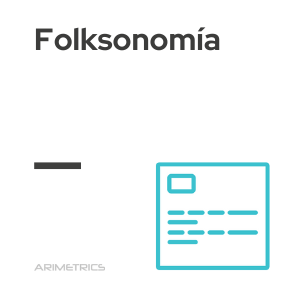 Definition:
Definition:
Folksonomies are a set of natural language terms (tags) that are used to describe the content of a document or web resource. The term was coined by Thomas Van Der Wal by merging the words folk (people, popular) and taxonomy (Management -taxis- of the classification -nomos-).
Types of Folksonomies
- Narrow Folksonomy: In this model, the content creator or a small group of people tag the content. This approach is often tied to specific objects, which can limit the emergence of new descriptions or vocabularies.
- Broad Folksonomy: Here, it is the users who apply the tags, allowing for greater linguistic and semantic diversity. This approach is more flexible and better reflects the interpretations and needs of a broad community.
What is a Folksonomy for?
Folksonomies are essential for the classification and organization of content on the Internet. They enable a more effective search on digital platforms, transforming users into active participants who contribute to the categorization and classification of publications. This continuous interaction fosters the evolution of the system, ensuring that categories remain relevant and up-to-date. For companies, the strategic use of folksonomies can increase the visibility and reach of their publications, making it easier to connect with specific audiences.
Folksonomies and Ontologies
Folksonomies and ontologies represent two distinct approaches to information organization and classification, each with its own advantages and challenges. The development of folksontologies seeks to combine the best of both worlds, integrating the flexibility and collaborative nature of folksonomies with the formal and rigorous structure of ontologies.
Folksonomies
Folksonomies are user-generated tagging systems that enable the collaborative classification and organization of content. This approach is flexible and reflects the current interpretations and needs of a community. However, folksonomies can lack consistency and accuracy due to problems such as language ambiguity and lack of terminology control.
Ontologies
On the other hand, ontologies are formal structures that define a set of concepts within a domain and the relationships between them. They are used to ensure consistency and precision in the representation of information, facilitating interoperability between systems. Ontologies are especially useful in fields that require a high degree of accuracy and standardization, such as artificial intelligence and natural language processing. However, they can be rigid and do not always reflect the evolution of language and community practices.
Integration in Folksontologies
The folksontologies concept seeks to bring these two approaches together to create a classification system that is both flexible and structured. The idea is to leverage the ability of folksonomies to capture the diversity and evolution of language, while using the structure of ontologies to provide consistency and precision.
- Capturing shared meanings: By combining folksonomies and ontologies, shared meanings within a community can be extracted, enabling a deeper understanding of the data. This is especially useful in social media platforms and online communities where language and trends change rapidly.
- Data structuring: The formal structure of ontologies provides a framework for organizing and categorizing information in a coherent manner, facilitating data search and retrieval.
- Interoperability: The integration of ontologies makes systems more interoperable, facilitating communication and information exchange between different platforms and applications.
- Continuous evolution: folksontologies can adapt as the needs and language of the community change, ensuring that the classification system remains relevant and useful.
Criticism of Folksonomies
Although folksonomies offer advantages such as ease of use and open participation, they face criticism due to:
- Language ambiguity: Polysemy and synonymy can complicate semantic precision.
- Spelling errors: Lack of control can lead to incorrectly spelled terms.
- Imprecision in the assignment of terms: The absence of a labeling policy and semantic relationships can reduce effectiveness.
- Lack of stemming: The absence of methods to reduce words to their root can generate inconsistencies.
To maximize the potential of folksonomies, it is essential to implement strategies that address these limitations, thereby improving the quality and usefulness of the collaborative tagging system.
